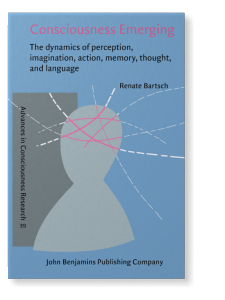Consciousness Emerging
The dynamics of perception, imagination, action, memory, thought, and language
Author
This study of the workings of neural networks in perception and understanding of situations and simple sentences shows that, and how, distributed conceptual constituents are bound together in episodes within an interactive/dynamic architecture of sensorial and pre-motor maps, and maps of conceptual indicators (semantic memory) and individuating indicators (historical, episodic memory). Activation circuits between these maps make sensorial and pre-motor fields in the brain function as episodic maps creating representations, which are expressions in consciousness. It is argued that all consciousness is episodic, consisting of situational or linguistic representations, and that the mind is the whole of all conscious manifestations of the brain. Thought occurs only in the form of linguistic or image representations. The book also discusses the role of consciousness in the relationship between causal and denotational semantics, and its role for the possibility of representations and rules. Four recent controversies in consciousness research are discussed and decided along this model of consciousness:
- Is consciousness an internal or external monitoring device of brain states?
- Do all conscious states involve thought and judgement?
- Are there different kinds of consciousness?
- Do we have a one-on-one correspondence between certain brain states and conscious states.
[Advances in Consciousness Research, 39] 2002. x, 256 pp.
Publishing status: Available
© John Benjamins Publishing Company
Table of Contents
-
Preface | pp. vii–ix
-
1. Consciousness and intentionality in perception, semantics, representations, and rules | pp. 1–74
-
2. Formal constraints on the relationship between understanding and Connectionist Neural Networks | pp. 75–127
-
3. An architecture of episodic and conceptual maps for understanding basic sentences and situations | pp. 129–164
-
4. Evaluation, thought, imagery, and language | pp. 165–186
-
5. Controversial issues in consciousness research | pp. 187–236
-
Conclusion | pp. 237–241
-
-
Index | pp. 249–256
“The overall structure of the book is very clear, taking the reader from a foundational philosophical argumentation to a detailed conceptual - yet not too technical - description of the workings of the account, before it finally deals with some interesting theoretical implications thereof.”
Daniel Wiechmann,
Friedrich Schiller University, Jena, Germany, in ICLA-review, February 2008
Cited by
Cited by 7 other publications
Blutner, Reinhard
Martín de León, Celia
Talvitie, Vesa & Hannu Tiitinen
Zibin, Aseel, Lama Khalifah & Abdel Rahman Mitib Altakhaineh
[no author supplied]
This list is based on CrossRef data as of 12 april 2024. Please note that it may not be complete. Sources presented here have been supplied by the respective publishers. Any errors therein should be reported to them.
Subjects
Consciousness Research
Linguistics
Philosophy
Psychology
Main BIC Subject
HP: Philosophy
Main BISAC Subject
PHI000000: PHILOSOPHY / General
